
This is a list of people treated with electroconvulsive therapy (ECT).
- Linda Andre, American author, activist, director of the Committee for Truth in Psychiatry (CTIP), and self-described psychiatric survivor. [1] [2]
- Louis Althusser, French marxist philosopher [ citation needed ]
- Antonin Artaud, French poet and playwright [3] [4]
- Dick Cavett, American television talk show host [5]
- Ted Chabasinski, American attorney, activist, and self-described psychiatric survivor who received ECT at six years of age. [6] [7]
- Clementine Churchill, wife of Sir Winston Churchill [8]
- Paulo Coelho, author of The Alchemist [9]
- Simone D., a pseudonym for a psychiatric patient in the Creedmoor Psychiatric Center in New York, [10] who in 2007 won a court ruling which set aside a two-year-old court order to give her electroshock treatment against her will [11] [12]
- Duplessis Orphans Orphans of the 1950s in the province of Quebec, Canada, endured electroshock.
- Kitty Dukakis, wife of former Massachusetts governor and 1988 Democratic presidential nominee Michael Dukakis and author of Shock, [13] a book chronicling her experiences with ECT [14]
- Thomas Eagleton, US senator and vice presidential candidate [15]
- Eduard Einstein (28 July 1910 – 25 October 1965) Albert Einstein's second son had ECT. Hans Albert Einstein, his brother thought the psychiatric treatment made him worse. [16]
- Roky Erickson, American singer, songwriter, harmonica player and guitarist [17]
- Frances Farmer, American film actress, who described standing in line with other girls at mental hospital waiting for shock treatments in the 1940s.
- Carrie Fisher, American actress and novelist [18] Fisher speaks at length of her experiences with ECT in her autobiography Wishful Drinking .
- Janet Frame, New Zealand writer and poet [19]
- Leonard Roy Frank, is a published author, human rights activist, and self-described psychiatric survivor. [20] [21]
- Judy Garland, Singer, dancer, actress.
- Harold Gimblett, British cricketer [22]
- Julie Goodyear, English actress from Coronation Street. [23]
- Gloria Grahame Actress. (1964)
- Peter Green, English blues guitarist, founding member of Fleetwood Mac. [24] [25]
- David Helfgott, Australian pianist [26]
- Ernest Hemingway, American Pulitzer Prize–winning novelist, Nobel Laureate, short-story writer, and journalist [27] [28]
- Gloria Hemingway, daughter of Ernest Hemingway
- Marya Hornbacher, American writer [29]
- Vladimir Horowitz, Russian-American classical pianist [30]
- Vivien Leigh, English actress and second wife of Laurence Olivier [31]
- Oscar Levant, American pianist, composer, television and film personality [32]
- Carmen Miranda, Luso-Brazilian Singer, dancer, actress[ citation needed ]
- Michael Moriarty, American actor [33]
- Robbie Muir, Australian rules football player - when aged seven. [34]
- Sherwin B. Nuland, American surgeon and writer [35]
- Andrew Loog Oldham, manager of The Rolling Stones [ citation needed ]
- Karolina Olsson, the "Sleeping Beauty of Oknö"[ citation needed ]
- Sam Phillips, founder, Sun Records, discoverer of Elvis Presley [36]
- Robert M. Pirsig, who later wrote about his experience in the autobiographical novel Zen and the Art of Motorcycle Maintenance .
- Sylvia Plath, American writer and poet [37] [38]
- Emil Post, American mathematician, died in 1954 of a heart attack following electroshock treatment for depression; [39] [40] he was 57.
- Bud Powell, American jazz musician [41]
- Lou Reed, American singer-songwriter [42] [43]
- Marilyn Rice, anti-electroconvulsive therapy activist [44]
- Paul Robeson, American bass singer and actor [45]
- Yves Saint-Laurent, French fashion designer [46]
- Peggy S. Salters, from South Carolina, in 2005 became the first survivor of electroshock treatment in the United States to win a jury verdict and a large money judgment ($635,177) in compensation for extensive permanent amnesia and cognitive disability caused by the procedure [47]
- Edie Sedgwick, American socialite and Warhol superstar [48]
- William Styron, American author [49]
- Gene Tierney, American actress [50]
- Townes van Zandt, American country singer-songwriter [51]
- David Foster Wallace, American writer [52]
- Mike Wallace, American journalist [53]
- Tammy Wynette, American country singer and composer, who described having a series of shock treatments for depression in her biography.[ citation needed ]